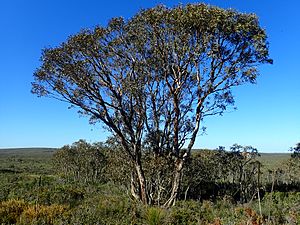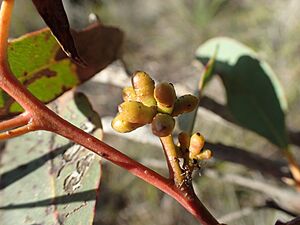Cadda Road mallee facts for kids
Quick facts for kids Cadda Road mallee |
|
|---|---|
 |
|
| Eucalyptus × balanites near Badgingarra | |
| Conservation status | |
| Scientific classification | |
| Genus: |
Eucalyptus
|
| Species: |
× balanites
|
The Cadda Road mallee (scientific name: Eucalyptus × balanites) is a special type of tree or a mallee. A mallee is a plant that grows many stems from a large, woody base called a lignotuber. This plant is found only in a small part of Western Australia, mainly in the south-west.
It has rough, corky bark and long, thin adult leaves. Its flowers are creamy-white and grow in groups of eleven. After the flowers, it produces fruit that looks like a small cup or half a ball.
Contents
What is the Cadda Road Mallee?
The Cadda Road mallee is a tree or a mallee that usually grows up to 5 meters (about 16 feet) tall. It has a special woody base called a lignotuber that helps it regrow after fires.
Its bark is rough and can be corky or flaky. It's usually pale grey to yellowish on the main trunk and bigger branches. The smaller, upper stems have thin, papery bark.
Leaves and Flowers
Young plants and new shoots have oval-shaped leaves. These leaves can be up to 65 mm (about 2.5 inches) long and 35 mm (about 1.4 inches) wide. They always have a small stalk, called a petiole.
Adult leaves are usually shaped like a spear. They are 65 to 135 mm (about 2.5 to 5.3 inches) long and 9 to 18 mm (about 0.35 to 0.7 inches) wide. Their petioles are 10 to 18 mm (about 0.4 to 0.7 inches) long.
The flowers grow in groups of eleven. They are found where the leaves meet the stem, in an area called a leaf axil. Each group of flowers grows on a stalk called a peduncle, which is 7 to 15 mm long. Each individual flower has its own tiny stalk, called a pedicel, which is 1 to 2 mm long.
Flower Buds and Fruit
Before they open, the flower buds are oval-shaped. They are 8 to 11 mm long and 6 to 7 mm wide. The top part of the bud, called the operculum, is rounded or cone-shaped. There's a small squeeze or "constriction" at the bottom of this cap.
The Cadda Road mallee flowers from October to February. Its flowers are a lovely creamy-white color.
After flowering, the plant produces fruit. This fruit is a capsule that looks like half a ball or a cup. It's 8 to 9 mm long and 8 to 10 mm wide. The parts that hold the seeds (called valves) do not stick out above the rim of the fruit.
A Natural Hybrid
The Australian Plant Census, which keeps track of all Australian plants, lists the Cadda Road mallee as a natural hybrid. This means it's a mix of two other eucalyptus species: Eucalyptus decipiens and Eucalyptus lane-poolei.
How it Got its Name
The Cadda Road mallee was first officially described in 1992. Two scientists, Peter Grayling and Ian Brooker, gave it the scientific name Eucalyptus balanites. They published their description in a science journal called Nuytsia.
The name balanites comes from an Ancient Greek word, balanos. This word means "acorn" or "barnacle." The scientists chose this name because the flower buds look a bit like acorns.
Where Does it Live?
The Cadda Road mallee grows in areas with heathland and open mallee woodlands. It's found in a few separate places, including the Badgingarra National Park and on the coastal plain near the city of Perth.
Is it Endangered?
Yes, the Cadda Road mallee is considered "endangered." This means it's at a very high risk of disappearing from the wild.
It's listed as endangered by the Australian Government under a law called the Environment Protection and Biodiversity Conservation Act 1999. It's also listed as "Threatened Flora" by the Department of Environment and Conservation in Western Australia.
What are the Threats?
Scientists have created a plan to help this species recover. The main things that threaten the Cadda Road mallee are:
- Fires: Fires that happen too often or at the wrong time can harm the plants.
- Disease: A plant disease caused by a tiny organism called Phytophthora cinnamomi can make the plants sick.
- Weeds: Other plants, called weeds, can invade its habitat and compete for resources.
Also, this species doesn't produce many healthy fruits or fertile seeds. The pollen, which is needed for reproduction, is also not very strong. This makes it harder for new plants to grow.
In 2012, two other scientists, Dean Nicolle and Malcolm French, suggested that because Eucalyptus balanites is a hybrid, it might not need to be on the threatened plants list. However, it is still considered endangered.





